Guiliang Liu
Toward Humanoid Brain-Body Co-design: Joint Optimization of Control and Morphology for Fall Recovery
Oct 25, 2025Abstract:Humanoid robots represent a central frontier in embodied intelligence, as their anthropomorphic form enables natural deployment in humans' workspace. Brain-body co-design for humanoids presents a promising approach to realizing this potential by jointly optimizing control policies and physical morphology. Within this context, fall recovery emerges as a critical capability. It not only enhances safety and resilience but also integrates naturally with locomotion systems, thereby advancing the autonomy of humanoids. In this paper, we propose RoboCraft, a scalable humanoid co-design framework for fall recovery that iteratively improves performance through the coupled updates of control policy and morphology. A shared policy pretrained across multiple designs is progressively finetuned on high-performing morphologies, enabling efficient adaptation without retraining from scratch. Concurrently, morphology search is guided by human-inspired priors and optimization algorithms, supported by a priority buffer that balances reevaluation of promising candidates with the exploration of novel designs. Experiments show that \ourmethod{} achieves an average performance gain of 44.55% on seven public humanoid robots, with morphology optimization drives at least 40% of improvements in co-designing four humanoid robots, underscoring the critical role of humanoid co-design.
SignBot: Learning Human-to-Humanoid Sign Language Interaction
May 30, 2025Abstract:Sign language is a natural and visual form of language that uses movements and expressions to convey meaning, serving as a crucial means of communication for individuals who are deaf or hard-of-hearing (DHH). However, the number of people proficient in sign language remains limited, highlighting the need for technological advancements to bridge communication gaps and foster interactions with minorities. Based on recent advancements in embodied humanoid robots, we propose SignBot, a novel framework for human-robot sign language interaction. SignBot integrates a cerebellum-inspired motion control component and a cerebral-oriented module for comprehension and interaction. Specifically, SignBot consists of: 1) Motion Retargeting, which converts human sign language datasets into robot-compatible kinematics; 2) Motion Control, which leverages a learning-based paradigm to develop a robust humanoid control policy for tracking sign language gestures; and 3) Generative Interaction, which incorporates translator, responser, and generator of sign language, thereby enabling natural and effective communication between robots and humans. Simulation and real-world experimental results demonstrate that SignBot can effectively facilitate human-robot interaction and perform sign language motions with diverse robots and datasets. SignBot represents a significant advancement in automatic sign language interaction on embodied humanoid robot platforms, providing a promising solution to improve communication accessibility for the DHH community.
Real-Time Verification of Embodied Reasoning for Generative Skill Acquisition
May 19, 2025Abstract:Generative skill acquisition enables embodied agents to actively learn a scalable and evolving repertoire of control skills, crucial for the advancement of large decision models. While prior approaches often rely on supervision signals from generalist agents (e.g., LLMs), their effectiveness in complex 3D environments remains unclear; exhaustive evaluation incurs substantial computational costs, significantly hindering the efficiency of skill learning. Inspired by recent successes in verification models for mathematical reasoning, we propose VERGSA (Verifying Embodied Reasoning in Generative Skill Acquisition), a framework that systematically integrates real-time verification principles into embodied skill learning. VERGSA establishes 1) a seamless extension from verification of mathematical reasoning into embodied learning by dynamically incorporating contextually relevant tasks into prompts and defining success metrics for both subtasks and overall tasks, and 2) an automated, scalable reward labeling scheme that synthesizes dense reward signals by iteratively finalizing the contribution of scene configuration and subtask learning to overall skill acquisition. To the best of our knowledge, this approach constitutes the first comprehensive training dataset for verification-driven generative skill acquisition, eliminating arduous manual reward engineering. Experiments validate the efficacy of our approach: 1) the exemplar task pool improves the average task success rates by 21%, 2) our verification model boosts success rates by 24% for novel tasks and 36% for encountered tasks, and 3) outperforms LLM-as-a-Judge baselines in verification quality.
Prof. Robot: Differentiable Robot Rendering Without Static and Self-Collisions
Mar 17, 2025



Abstract:Differentiable rendering has gained significant attention in the field of robotics, with differentiable robot rendering emerging as an effective paradigm for learning robotic actions from image-space supervision. However, the lack of physical world perception in this approach may lead to potential collisions during action optimization. In this work, we introduce a novel improvement on previous efforts by incorporating physical awareness of collisions through the learning of a neural robotic collision classifier. This enables the optimization of actions that avoid collisions with static, non-interactable environments as well as the robot itself. To facilitate effective gradient optimization with the classifier, we identify the underlying issue and propose leveraging Eikonal regularization to ensure consistent gradients for optimization. Our solution can be seamlessly integrated into existing differentiable robot rendering frameworks, utilizing gradients for optimization and providing a foundation for future applications of differentiable rendering in robotics with improved reliability of interactions with the physical world. Both qualitative and quantitative experiments demonstrate the necessity and effectiveness of our method compared to previous solutions.
GAT-Grasp: Gesture-Driven Affordance Transfer for Task-Aware Robotic Grasping
Mar 08, 2025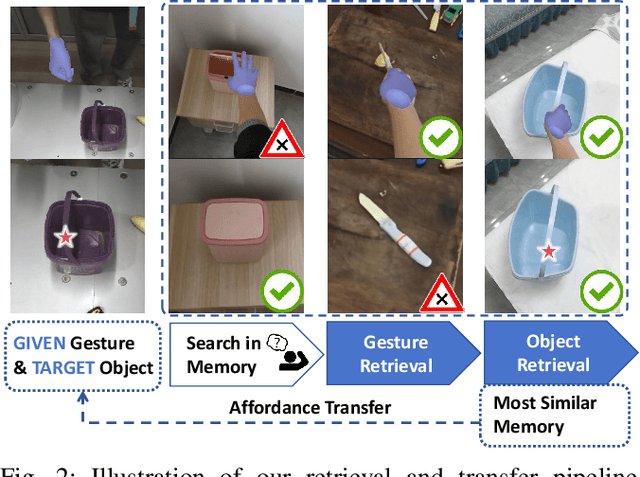
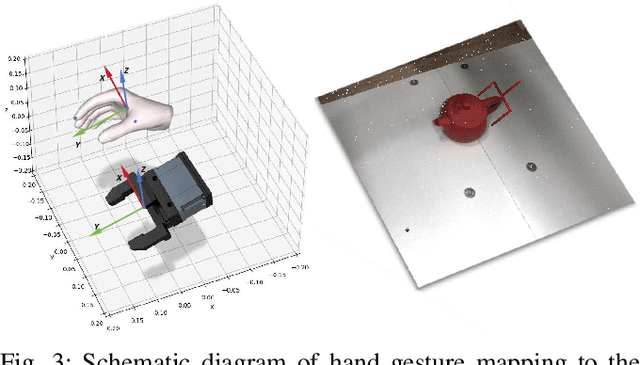
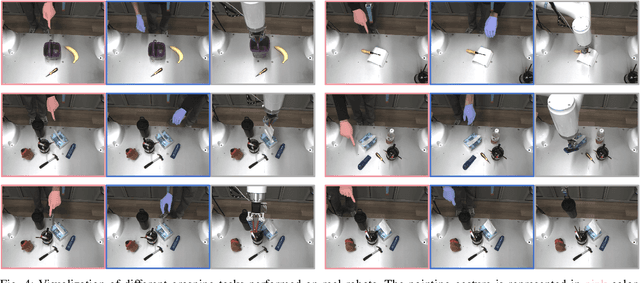
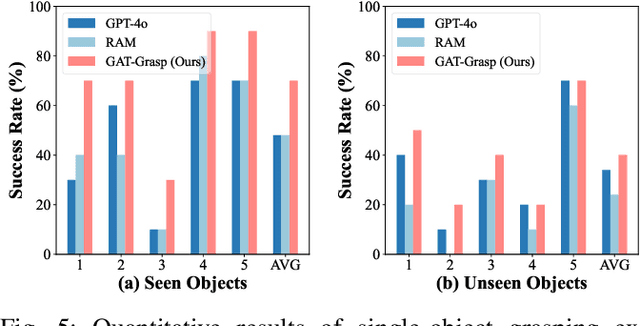
Abstract:Achieving precise and generalizable grasping across diverse objects and environments is essential for intelligent and collaborative robotic systems. However, existing approaches often struggle with ambiguous affordance reasoning and limited adaptability to unseen objects, leading to suboptimal grasp execution. In this work, we propose GAT-Grasp, a gesture-driven grasping framework that directly utilizes human hand gestures to guide the generation of task-specific grasp poses with appropriate positioning and orientation. Specifically, we introduce a retrieval-based affordance transfer paradigm, leveraging the implicit correlation between hand gestures and object affordances to extract grasping knowledge from large-scale human-object interaction videos. By eliminating the reliance on pre-given object priors, GAT-Grasp enables zero-shot generalization to novel objects and cluttered environments. Real-world evaluations confirm its robustness across diverse and unseen scenarios, demonstrating reliable grasp execution in complex task settings.
HWC-Loco: A Hierarchical Whole-Body Control Approach to Robust Humanoid Locomotion
Mar 02, 2025Abstract:Humanoid robots, capable of assuming human roles in various workplaces, have become essential to the advancement of embodied intelligence. However, as robots with complex physical structures, learning a control model that can operate robustly across diverse environments remains inherently challenging, particularly under the discrepancies between training and deployment environments. In this study, we propose HWC-Loco, a robust whole-body control algorithm tailored for humanoid locomotion tasks. By reformulating policy learning as a robust optimization problem, HWC-Loco explicitly learns to recover from safety-critical scenarios. While prioritizing safety guarantees, overly conservative behavior can compromise the robot's ability to complete the given tasks. To tackle this challenge, HWC-Loco leverages a hierarchical policy for robust control. This policy can dynamically resolve the trade-off between goal-tracking and safety recovery, guided by human behavior norms and dynamic constraints. To evaluate the performance of HWC-Loco, we conduct extensive comparisons against state-of-the-art humanoid control models, demonstrating HWC-Loco's superior performance across diverse terrains, robot structures, and locomotion tasks under both simulated and real-world environments.
You Only Teach Once: Learn One-Shot Bimanual Robotic Manipulation from Video Demonstrations
Jan 24, 2025Abstract:Bimanual robotic manipulation is a long-standing challenge of embodied intelligence due to its characteristics of dual-arm spatial-temporal coordination and high-dimensional action spaces. Previous studies rely on pre-defined action taxonomies or direct teleoperation to alleviate or circumvent these issues, often making them lack simplicity, versatility and scalability. Differently, we believe that the most effective and efficient way for teaching bimanual manipulation is learning from human demonstrated videos, where rich features such as spatial-temporal positions, dynamic postures, interaction states and dexterous transitions are available almost for free. In this work, we propose the YOTO (You Only Teach Once), which can extract and then inject patterns of bimanual actions from as few as a single binocular observation of hand movements, and teach dual robot arms various complex tasks. Furthermore, based on keyframes-based motion trajectories, we devise a subtle solution for rapidly generating training demonstrations with diverse variations of manipulated objects and their locations. These data can then be used to learn a customized bimanual diffusion policy (BiDP) across diverse scenes. In experiments, YOTO achieves impressive performance in mimicking 5 intricate long-horizon bimanual tasks, possesses strong generalization under different visual and spatial conditions, and outperforms existing visuomotor imitation learning methods in accuracy and efficiency. Our project link is https://hnuzhy.github.io/projects/YOTO.
Offline Inverse Constrained Reinforcement Learning for Safe-Critical Decision Making in Healthcare
Oct 10, 2024



Abstract:Reinforcement Learning (RL) applied in healthcare can lead to unsafe medical decisions and treatment, such as excessive dosages or abrupt changes, often due to agents overlooking common-sense constraints. Consequently, Constrained Reinforcement Learning (CRL) is a natural choice for safe decisions. However, specifying the exact cost function is inherently difficult in healthcare. Recent Inverse Constrained Reinforcement Learning (ICRL) is a promising approach that infers constraints from expert demonstrations. ICRL algorithms model Markovian decisions in an interactive environment. These settings do not align with the practical requirement of a decision-making system in healthcare, where decisions rely on historical treatment recorded in an offline dataset. To tackle these issues, we propose the Constraint Transformer (CT). Specifically, 1) we utilize a causal attention mechanism to incorporate historical decisions and observations into the constraint modeling, while employing a Non-Markovian layer for weighted constraints to capture critical states. 2) A generative world model is used to perform exploratory data augmentation, enabling offline RL methods to simulate unsafe decision sequences. In multiple medical scenarios, empirical results demonstrate that CT can capture unsafe states and achieve strategies that approximate lower mortality rates, reducing the occurrence probability of unsafe behaviors.
Provably Efficient Exploration in Inverse Constrained Reinforcement Learning
Sep 24, 2024
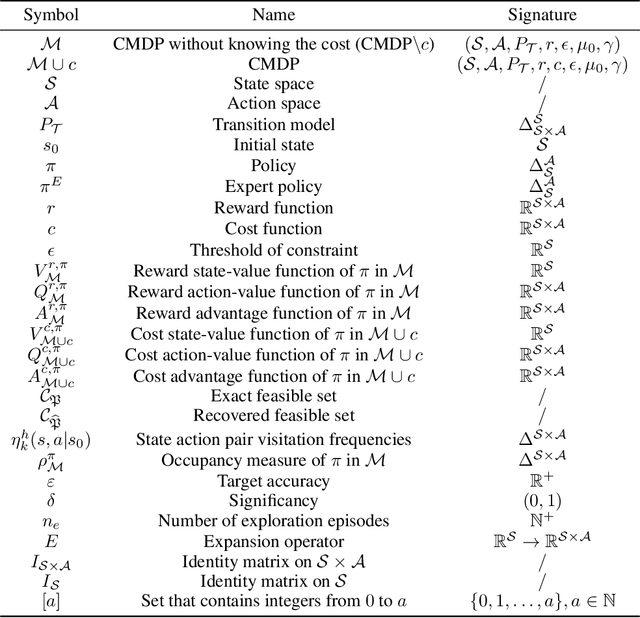
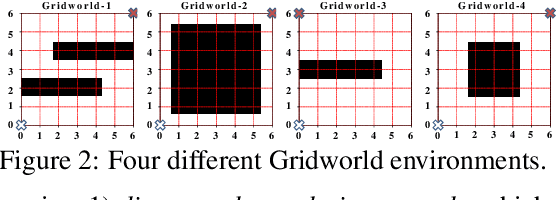
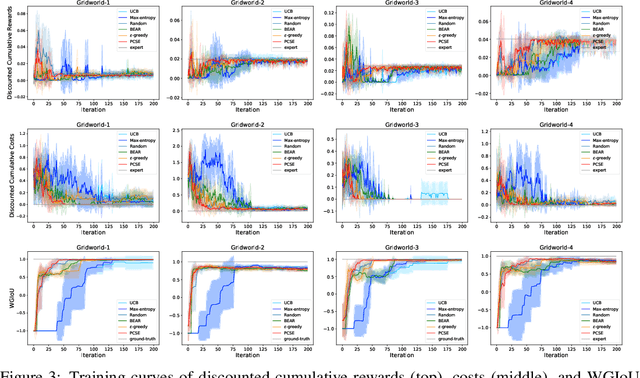
Abstract:To obtain the optimal constraints in complex environments, Inverse Constrained Reinforcement Learning (ICRL) seeks to recover these constraints from expert demonstrations in a data-driven manner. Existing ICRL algorithms collect training samples from an interactive environment. However, the efficacy and efficiency of these sampling strategies remain unknown. To bridge this gap, we introduce a strategic exploration framework with provable efficiency. Specifically, we define a feasible constraint set for ICRL problems and investigate how expert policy and environmental dynamics influence the optimality of constraints. Motivated by our findings, we propose two exploratory algorithms to achieve efficient constraint inference via 1) dynamically reducing the bounded aggregate error of cost estimation and 2) strategically constraining the exploration policy. Both algorithms are theoretically grounded with tractable sample complexity. We empirically demonstrate the performance of our algorithms under various environments.
A Survey of Inverse Constrained Reinforcement Learning: Definitions, Progress and Challenges
Sep 11, 2024



Abstract:Inverse Constrained Reinforcement Learning (ICRL) is the task of inferring the implicit constraints followed by expert agents from their demonstration data. As an emerging research topic, ICRL has received considerable attention in recent years. This article presents a categorical survey of the latest advances in ICRL. It serves as a comprehensive reference for machine learning researchers and practitioners, as well as starters seeking to comprehend the definitions, advancements, and important challenges in ICRL. We begin by formally defining the problem and outlining the algorithmic framework that facilitates constraint inference across various scenarios. These include deterministic or stochastic environments, environments with limited demonstrations, and multiple agents. For each context, we illustrate the critical challenges and introduce a series of fundamental methods to tackle these issues. This survey encompasses discrete, virtual, and realistic environments for evaluating ICRL agents. We also delve into the most pertinent applications of ICRL, such as autonomous driving, robot control, and sports analytics. To stimulate continuing research, we conclude the survey with a discussion of key unresolved questions in ICRL that can effectively foster a bridge between theoretical understanding and practical industrial applications.
 Add to Chrome
Add to Chrome Add to Firefox
Add to Firefox Add to Edge
Add to Edge